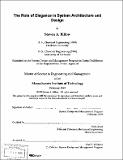The role of elegance in system architecture and design
Author(s)
Billow, Steven A. (Steven Arthur), 1967-
DownloadFull printable version (8.358Mb)
Advisor
Seth Lloyd.
Terms of use
Metadata
Show full item recordAbstract
The meaning and relevance of elegance in system architecture and design is considered. After establishing its desirability, elegance is defined by two criteria common to complex, elegant systems: 1. the system must function according to its stated purpose; and 2. the design pressures constraining the system design must be simultaneously relieved. These criteria were developed after discussion with experts in a wide variety of disciplines and after research of seven examples given by the experts in their respective fields. Aside from the criteria above, characteristics common to many elegant solutions are identified and discussed. The relativity of elegance is discussed with respect to variations in objectives, language, timing, and culture; and means to improve one's sense of elegance are suggested. Finally, methods to create elegant solutions are considered with special attention paid to those methods recognized in the elegant solutions considered within this text.
Description
Thesis (S.M.)--Massachusetts Institute of Technology, System Design and Management Program, 1999. Includes bibliographical references (p. 99-102).
Date issued
1999Publisher
Massachusetts Institute of Technology
Keywords
System Design and Management Program